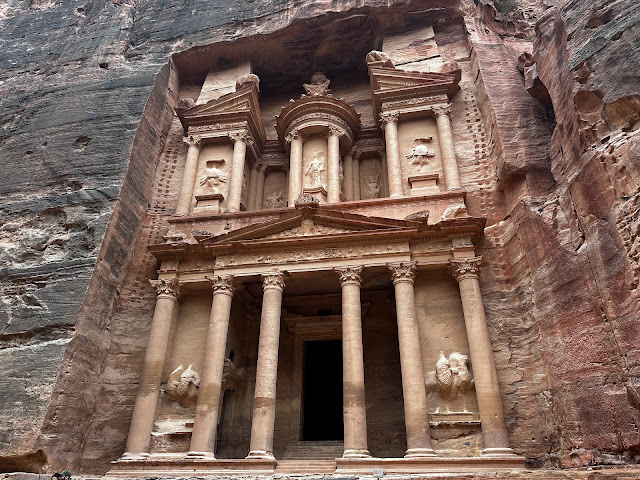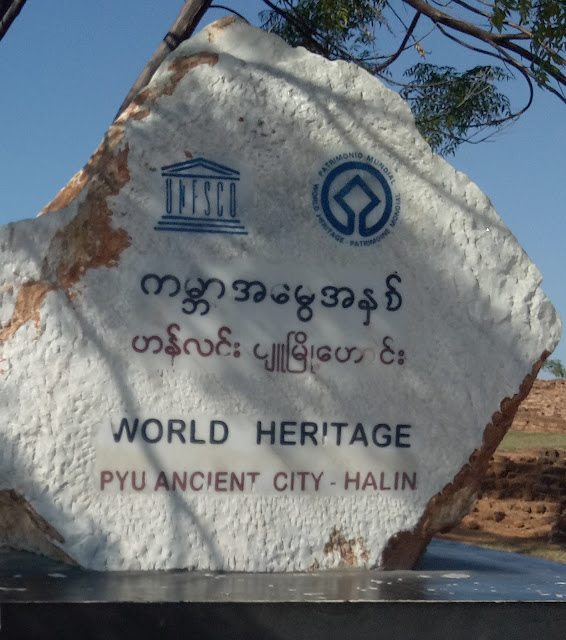In Yaśodharapura (modern day Angkor) which was
once the capital of the Khmer Empire (from the late 9th century CE to the early
15th Century CE), lies Angkor Wat. Once hidden amidst vast jungles and today
bustling with tourists, it is the largest religious monument in the world.
 |
The western entrance of Angkor Wat: Angkor Wat is oriented to the west unlike most Angkorian temples
Overview
Angkor Wat was founded by the Khmer “King
Suryavarman II” (reigned from 1113 CE - 1145/50 CE) during the early 12th
Century CE as a temple dedicated to the god Vishnu. In 1177 CE, approximately
27 years from the death of the king, Angkor was sacked by the rulers of “Champa”
(which was in the modern day central and southern Vietnam). The empire was
restored by “King Jayavarman VII” (reigned from 1181 CE - 1218 CE) who was a
devoted Buddhist. Angkor Wat itself gradually transformed into a Buddhist
temple towards the end of the 12th Century CE.
|
 |
The eastern entrance of Angkor Wat
|
Angkor Wat was designed combining the Khmer architectural concepts of the temple mountain and the galleried temple. It represents “Mount Meru”: the home of Devas in Hindu mythology. The central quincunx (i.e. an arrangement of five objects with four at the corners of a square or a rectangle and the fifth at its' center) of towers symbolizes the five peaks of the mountain, and the walls and moat symbolize the surrounding mountain ranges and ocean. It is likely that the access to the upper levels of the temple was based on the social status of the respective individuals and that the ordinary people may have only had access to the lowest level.
The main tower of the temple aligns to the
morning sun of the spring equinox. British writer and journalist Graham Hancock
known for his alternative historical theories related ancient civilizations
claimed during the late 1990s, that the structure of Angkor Wat represents the star
constellation of Draco (Dragon) as appeared on the sky over Angkor at the dawn
of the spring equinox in 10500 BCE. Hancock's theory was that an ancient civilization
predating the generally accepted history existed before the biblical great
flood, and the knowledge left behind post it's destruction could be seen
through a number of megalithic monuments around the world including the great
Sphinx and the great pyramids of Giza as well as Angkor Wat.
 |
The central tower which represents “Mount Meru”: the home of Devas in Hindu mythology
|
As it was later transformed into a Buddhist
temple, Angkor Wat also contains Buddha statues.
 |
One of the Buddha statues in Angkor Wat
|
Like many ancient monuments, Angkor Wat has also
utilized Naga balustrades at entry points as guardian statues. It could also be
observed the existence of buildings which have been identified as ancient
libraries.
 |
| One of the Naga balustrades in Angkor Wat |
 |
An ancient library in Angkor WatBas-relief depictions
One of the most significant aspects of Angkor
Wat is the extensive decorations on the inner walls of its’ galleries which
depicts legends and beliefs of Hindu mythology. These decorations primarily take
form of bas-relief friezes.
Bas-relief depiction of the churning of
the Sea of MilkThe eastern gallery has the famous depiction of
the Churning of the Sea of Milk. Referred to as the Samudra Manthana
in the in the "Bhagavata Purana", in the "Mahabharata" and in the "Vishnu Purana", it explains the
origin of Amrita, the nectar of
immortality. As per Hindu mythology, under the direction of god Vishnu, Devas
and Asuras churned the sea of milk using the serpent king (Nagaraja) Vasuki as
the churning rope and “Mount Mandara” as the churning rod.
The bas-reliefs depict Vishnu at the center of
the battle. Indra: The King of Svarga (Heaven) is depicted above Vishnu. Kurma:
the turtle avatar of Vishnu is depicted below Vishnu. Bas-reliefs of Apsaras
are depicted above the battle.  | Depiction of god Vishnu in the bas-relief of the Churning of the Sea of Milk
|
Asuras are depicted on the left-hand side of god Vishnu.
 | Depiction of Asuras in the bas-relief of the Churning of the Sea of Milk
|
Devas are depicted on right hand side of god Vishnu.  | Depiction of Devas in the bas-relief of the Churning of the Sea of Milk
|
As stated in Hindu mythology, the Devas can be seen
holding the head end of the serpent king Vasuki.
 | Devas using the serpent king (Nagaraja) Vasuki as the churning rope
|
Bas-relief depiction of the Sanskrit epic
of Ramayana
Another well known
depiction within the galleries of Angkor Wat is the epic of Ramayana which
tells the legend of Rama: prince of the Kosala Kingdom. The epic follows the
Rama’s travel across India with his wife Seetha and brother Lakshmana, the kidnapping
of Seetha by Ravana: the great king of Lanka, and Rama’s battle with Ravana to
rescue his wife Seetha with the aid of the Vanara king Hanuman.  | Prince Rama in the battle of Ramayana
|
 | King Ravana in the battle of Ramayana
 | Vanara King Hanuman in the battle of Ramayana
 | Depiction of the battle of Ramayana
|
 | Depiction of the battle of Ramayana
|
 | Depiction of the battle of Ramayana
|
|
|
Bas-relief depiction of heavens and hells
as described in Hindu mythologyAnother depiction within the galleries of Angkor Wat are the heavens and hells as described in Hindu mythology. This bas-relief contains three horizontal layers. The top level depicts “Svargas” (heavens). The middle level depicts “Bhoomi” (earth). The bottom layer depicts “Narakas” (hells). A prominent component of this bas-relief is the depiction of Yama: the Hindu god of death, mounted on his water-buffalo. Yama appears to be overlooking the proceedings of hell while his guards are punishing the sinners who have arrived at hell after death.  | Depiction of Yama: The Hindu god of death mounted on his water buffalo
 | Depiction of the torments of hell
 | Depiction of the torments of hell
 | Depiction of the torments of hell
|
|
|
|
World heritage status and tourismDesignated as a world heritage site by UNESCO
in 1992, Angkor Wat also appears as a symbol in Cambodia's national flag
representing "Religion" and as a dedication to integrity, justice and
heritage.
Today, Angkor Wat is the prime tourist attraction
of Cambodia. However, most such visits to this historical site may have been
inspired by the 2001 movie Lara Croft: Tomb Raider (starring Angelina Jolie). In
their hunt to capture the perfect self-portrait digital photograph, many visitors
overlook the cultural and historical significance of the monument as well as
the legends depicted on the inner walls of its’ galleries. On most days, the
site is extremely crowded which makes it difficult to fully explore all the aspects
of this architectural masterclass. |























Comments
Post a Comment